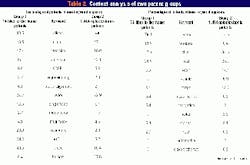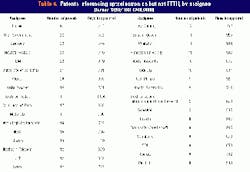Patent survey shows rapid increase in preparations for FTTH
The costs of packaging optoelectronics, integrating it, and coupling it to fiber remain high, but several companies are working hard to reduce costs.
STEPHEN N. BROWN
One year ago, Jeff Hecht, an author of textbooks on fiber optics and an expert in the field, wrote in MIT's Technology Review, "Fiber optics has helped push telecommunications into hyperdrive, but only when fiber connections reach all the way into the home will the technology's promise be fully realized." Like the opinions of other fiber advocates, Hecht's has a wistful quality, as if the promise can be met only in a dream or 25 years from now, whichever comes first.
For those of you less patient, be assured that inventors and major companies are striving mightily to make fiber's promise an immediate reality. This truth comes not from fortune-tellers reading crystal balls but from the vast efforts piling up as patents in the United States Patent and Trademark Office's (USPTO's) huge database, the most concentrated and expert source of knowledge available.
The USPTO's records show that patent 4978189, a "bidirectional...system for handling CATV and POTS [plain old telephone service]" assigned to AT&T Bell Labs in 1990, was the first one issued where fiber-to-the-home (FTTH) was a market consideration. Through 1996, few companies thought FTTH was worthwhile and almost no patents relating to it were filed and issued. However, the situation has changed: From November of 1998 to year-end 2000, the USPTO issued 74 patents to 32 major French, German, Japanese, American, and British companies that now have FTTH on their radar screens as either a threat or an opportunity.Table 1 identifies the companies, the number of patents assigned, and the "average days to approval," which is the lag time between the patent's filing date and issue date. Time lags range from 532 days to 1,338 days. Although the wide variation is not readily explainable, the lags show that a company's progress from concept to production is sometimes accomplished at barge-like speed, perhaps reducing the currency of the patent's embodied technology.
Not every FTTH reference in a patent means it focuses on FTTH. Some are references to scholarly sources such as Optics Letters and SPIE, while others are dismissive comments to justify an innovation on the copper plant: For example, 3Com states, "FTTH is still prohibitively expensive...an alternative is a combination of fiber cables feeding neighborhood optical-network units (ONUs) and last-leg premises connections by existing or new copper." Says Telcordia Technologies, "FTTH systems will not only require upgrading the loop plant, but will also require elimination of current loop electronics...[until then] advanced digital signal processing holds greatpromise for subscribers who desire broadband services...today." Scientific-Atlanta weighs in with, "FTTH...the costs of such an arrangement are currently prohibitive...there remains a need for a phased evolution of existing HFC [hybrid fiber/coax] systems, which pushes optical fibers deeper into the communications system."
Apparently, some attitudes toward FTTH never change. Scientific-Atlanta's comment about phased evolution is an opinion dating back at least 11 years when Jim Chiddix, now the senior vice president and chief technical officer of Time Warner, wrote about the "evolutionary adoption of new technology" in the February 1990 issue of IEEE LCS Magazine: "One constraint must be recognized...embedded investment ... cannot be casually discarded with the arrival of new technology." But Lucent's patent 6026144 displays a different attitude toward embedded investment: "It is well understood...that the legacy systems'...days are clearly numbered."
Cost-effective FTTH technology should cause a rush to discard embedded investment in the local telephone loop and the cable distribution networks, if economic reasoning prevails.
The USPTO has a long-established system where the patents are classified into one or more of 750 categories such as optical waveguides, optics systems, and active solid-state devices. The system has its uses, but it does not readily allow a subject-matter focus. A specific word search found 74 FTTH patents, and a context analysis of them establishes that certain concepts reoccur, suggesting the fundamentals of what will make FTTH economic.
For example, the words "coupling," "alignment," "substrate [chips]," and their variants appear in 61%, 40%, and 35% of the patents, respectively. These facts verify the current-day difficulties of FTTH technology, aptly put by British Telecom in patent 5852696: "The cost of packaging optical devices is one of the key economic barriers to the deployment of an FTTH," a fact emphasized by Picolight in patent 5940564: "Packaging is the largest-cost component for optoelectronics, typically making up 50-90% of the total cost. Thus, the simplified packaging forms most of the basis for lower costs."
Underlying these observations is the great economic cost of precisely aligning and coupling optoelectronics to fiber, especially singlemode. But that has led to serious investigation of vertical-cavity surface-emitting lasers (VCSELs) as one cure, as Picolight says: "Due to the lower beam divergence, the area in which a VCSEL may be placed with acceptable fiber coupling efficiency is four to nine times larger than that of an edge-emitter. Alignment is therefore far easier." That explains why VCSELs appear in five FTTH patents and why edge-emitters, normally used in long-haul telecommunications, are referenced not at all, except in a negative way.The context analysis makes it clear that progress in FTTH is tied to developments in optoelectronics, a very large field encompassing medical applications, weapons systems, radar, automotive applications, computers, scanners, and printers. But the basic logic of FTTH and optoelectronics issues are just about the same, according to the results of an expanded search covering 1,454 optoelectronics patents that did not reference FTTH but which were issued between December 1, 1998 and December 1, 2000. A context analysis of these patents shows the words "coupling," "alignment," and their variants appearing in 57% and 40% of the patents, respectively, a distribution almost perfectly matching that of the FTTH patents. "Substrate" appeared in 52% of the optoelectronics patents, an increase over the distribution in the FTTH patents, probably because optoelectronics has a broader scope of solid-state applications than telecommunications patents.
Table 2 shows the results of the context analysis of the 74 FTTH patents versus an analysis of the 1,454 optoelectronics patents where the same keywords were used. The results suggest that FTTH is more of a subcategory of the optoelectronics field than of "telecommunications."
The broader patent search revealed 538 different assignees, including several universities and the federal government. Significantly, many of the leading companies that received more than one FTTH patent are also major players in the optoelectronics field. Universities, which receive plenty of federal funding for optoelectronic and photonic research, have only one project related to FTTH.
Table 3 summarizes the distribution of patents by three large categories: universities, private sector, and government. Table 4 shows the same type of information as Table 1 but shortens the assignee listing to 32 assignees who received about 30% of the patents. (Note that the number of patents attributed to the U.S. government in Table 4 is two less than in Table 3. That's because Table 3 includes patents in which the government was co-recipient with a university.)
Space constraints prevent a full description of all the innovation present in such a large number of patents, but we can still highlight where many efforts are aimed. Joint research by Lucent Technologies, Boeing, and Motorola culminated in patent 5857049, "Precision alignment of optoelectronic devices," a method to replace "active" and "self" alignment of optoelectronic devices with fiber by using "slots, trenches," and an "effector arm of a robot" to "push and pull a positioning member" while an "optoelectronic device is energized" and the "positioning members are incrementally adjusted" until the light detected in the fiber "is maximized."Molex, in patent 5993074, says the "performance of the electro-optical signal translators depends as much upon the alignment of their component elements...with the corresponding optical channels as [on] the performance of each individual element" and offers a passive alignment technique to reduce the labor costs of optoelectronics. RVM Scientific in patent 5932397 describes how "polymer waveguide fabrication processes" cannot make low optical loss devices which "accommodate multiple sizes of singlemode waveguides in a single device" and then discusses how to achieve that goal with a "three-dimensional control of refractive-index gradients within films [which] permits the fabrication of tapers in the vertical (depth) dimensions" of such devices.
Lightpath in patent 6033515 describes a method to "fusion-splice a singlemode optical fiber directly to a collimating lens, a filter, a grating, a prism, a wavelength-division multiplexer (WDM) device, or any other optical component of comparatively larger cross-sectional area [than singlemode fiber]," another potential cure to the alignment problem. Patents by Lucent, BT, and Gore Associates envision a WDM-FTTH system, with the Gore patent heavily using VCSELs. NEC in patent 5872644 reduces the number of optical interfaces at a central office to 1/16th the number of FTTH subscribers served from the office.
Some patents focus on network-interface devices at the subscriber premises, others apply to efficient coupling of singlemode-to-multimode fiber, while others step away from singlemode. For example, Hewlett-Packard in patent 6012855 (which took nearly five years for approval) believes singlemode serial data links too expensive and relies on multimode fiber to develop parallel optical data links so that "packaging costs are amortized over many data channels, making the parallel optical data link of the invention less costly per data channel than serial-data-link alternatives," thus avoiding the high insertion losses of singlemode.
The singlemode/multimode dichotomy runs through the FTTH and optoelectronics patents. Singlemode and its synonym, "monomode," appear four times more often in the FTTH patents than do multimode references. In the optoelectronics patents singlemode and monomode references appear twice as often as multimode ones. It's not clear yet which form of fiber will prevail in an FTTH infrastructure.
In 1980, 48 patents having the term "optoelectronic" were issued. Since then, the number of optoelectronics patents issued has increased at an annual rate above 12%. This fact, coupled with the establishment of optoelectronics specialty programs at several universities, means that the body of knowledge and expertise in the field has been growing for two decades, time enough to develop a critical mass that will make FTTH economical.
All of which suggests that FTTH is not a distant dream and that the road in front of the industry should be different and shorter than the one already traveled. Now that we are living in the 21st century, it would be wonderful for the nation to have a corresponding communications infrastructure.
Stephen N. Brown specializes in market research and public policy toward new technology in the telecommunications industry. For more information call (615) 399-1239.




